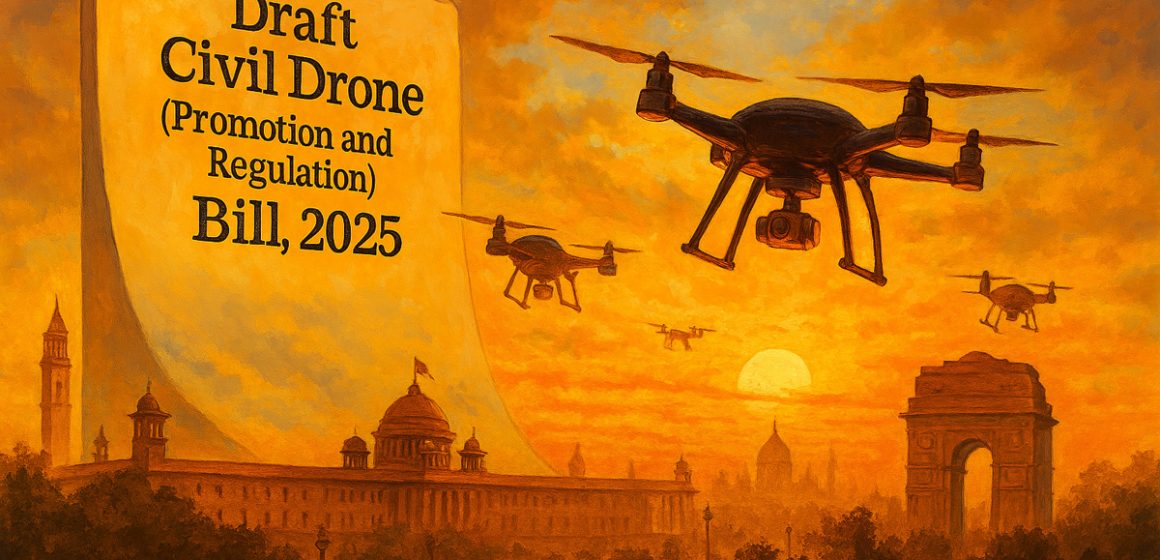In a move that sidesteps India’s Pre-Legislative Consultation norms, the Civil Aviation Ministry has given stakeholders just 15 days to respond to a draft drone Bill, raising fears it could stall the sector’s growth driven by reforms personally championed by Prime Minister Narendra Modi.
In a move that has stunned India’s fledgling yet fast-growing drone ecosystem, the Ramamohan Naidu Kinjarapu-led Ministry of Civil Aviation quietly published the ‘Draft Civil Drone (Promotion and Regulation) Bill, 2025’ on its website on Tuesday, inviting public comments.
What is ironic is that this has happened within a week of the central government announcing a long-awaited tax relief for the drone sector, slashing GST to a uniform 5 per cent from the earlier 18-28 per cent range.
The ministry has called for feedback from the “general public, industry and other stakeholders” by 30 September, a timeline that, while not unprecedented, is unusually short. The Pre-Legislative Consultation Policy (PLCP), introduced by the Central Government in 2014, mandates that draft legislation be accompanied by an explanatory note, financial implications, and an assessment of its impact on citizens. Crucially, it recommends a minimum of 30 days for public consultation before a Bill proceeds to Cabinet approval.
Critics argue that the truncated window limits meaningful stakeholder engagement and undermines the spirit of participatory policymaking.
Industry insiders warn that the liberalisation and reforms introduced under the Drone Rules, 2021—widely hailed as a landmark shift under Prime Minister Narendra Modi’s government—may now be at risk of reversal. Those rules had simplified compliance, decriminalised most offences, and fostered an innovation-friendly environment that positioned India as a potential global drone hub.
The new draft, however, appears to reintroduce several of the very compliance burdens that were removed just four years ago. “Offences that had been made civil in nature are once again being criminalised, with provisions for imprisonment of up to three years. The draft also gives police the power to confiscate drones on mere suspicion, with detention periods extendable by court order,” a person told INFRASTRUCTURE TODAY on condition of anonymity.
Such measures, the person added, risk creating an atmosphere of fear for legitimate operators and innovators, while doing little to curb non-compliance by rogue actors.
Ambiguous and Draconian
A close reading of the Bill reveals several provisions that have raised alarm across the drone ecosystem for their potentially punitive and regressive nature. Some clauses are ambiguous, while others may be considered draconian.
Sections 27(8) and 31(3), for instance, make violations of airspace restrictions and carriage of prohibited items cognisable and non-compoundable offences, punishable with up to three years’ imprisonment and a fine of ₹100,000. This marks a sharp departure from the Drone Rules, 2021, which had decriminalised most infractions to encourage innovation.
Section 35 empowers police and the aviation watchdog, the Directorate General of Civil Aviation (DGCA)-authorised officers to detain drones, documents, and electronic devices for up to seven days on mere suspicion of violation, extendable by court order. Drones may be released only upon execution of a bond and furnishing of security, even before formal charges are filed. This introduces a climate of uncertainty for legitimate operators and startups, with broad discretionary powers and limited procedural safeguards.
Emergency powers under Section 33 allow the central government to cancel certificates, suspend operations, or seize drones in the interest of “sovereignty, integrity, or public order”, without prior hearing or judicial oversight. The language is sweeping and could be used to restrict operations or target specific classes of drones arbitrarily.
Section 8 mandates that all drones incorporate safety and security features as prescribed by the government. Tampering with or modifying these features is a punishable offence. While safety is paramount, the lack of clarity on what constitutes “mandatory” features and the absence of a transition period could stifle innovation and penalise legacy systems.
Sections 6, 7, and 26 prohibit the sale, transfer, or import of drones without registration and type certification. This could severely impact small manufacturers and hobbyists in the absence of clear exemptions or a streamlined certification framework.
Section 23 reintroduces remote pilot certification requirements, prohibiting individuals from operating drones—even for recreational use—without formal licensing. This reverses the relaxed norms of 2021 and may deter casual users and educational institutions from engaging with drone technology.
Section 27(8) criminalises airspace violations, making unauthorised flights in red or yellow zones a cognisable, non-compoundable offence. This could penalise accidental incursions, particularly in areas where airspace maps are outdated or not easily accessible to the public.
Absence of Meaningful Enforcement
Stakeholders find the lack of meaningful enforcement against existing violations equally disturbing. They allege that unregistered Chinese drones continue to be imported and operated without type certification, while uncertified agricultural drones are openly sold and flown without any deterrent action. The Bill’s emphasis on punitive provisions, without first addressing enforcement gaps through customs controls and DGCA oversight, risks penalising compliant players while allowing real violators to slip through.
They also caution that the draft legislation could undo the progress made since 2021. The reforms of that year were designed to shift the ecosystem from a “permission-heavy, penalty-heavy” regime to one that was light-touch, innovation-led, and trust-based. By reversing course, the Bill threatens to set the sector back by several years, eroding investor confidence and stalling momentum just as India’s drone industry begins to expand commercially and attract global interest.
Experts told INFRASTRUCTURE TODAY that the Bill may reflect a broader security-led review of drone operations, echoing earlier regulatory shifts in 2014 and 2018, before the sector was liberalised through the Drone Rules, 2021. The 2025 Bill may, therefore, be deemed regressive.
India currently has over 120 certified drone manufacturers, spanning sectors such as logistics, agriculture, and defence. Despite concerns over the continued use of Chinese components in some uncertified models, certain players played a pivotal role during Operation Sindoor, reinforcing the growing capabilities of India’s indigenous drone ecosystem.
-Manish Pant


